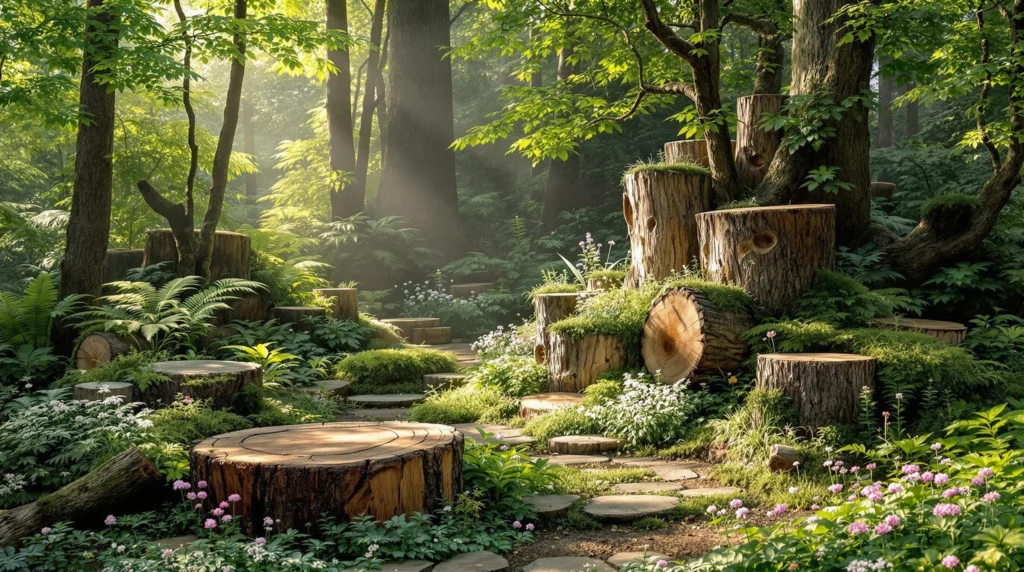What Is a Stumpery Garden: Understanding This Victorian Garden Trend
A stumpery garden is a unique industry feature that uses dead tree stumps, logs, and root systems arranged artistically to create a naturalistic woodland garden. Originating in Victorian England during the 19th century, stumperies first gained popularity as part of the era’s fascination with ferns and woodland plants. The concept was pioneered at Biddulph Grange in Staffordshire, where gardener Edward Cooke created elaborate displays using uprooted tree stumps. These gardens serve as both decorative elements and functional ecosystems, providing habitats for beneficial wildlife like insects, birds, and small mammals. Modern stumperies combine the Victorian aesthetic with contemporary sustainability principles, transforming what would otherwise be garden waste into charming focal points. You’ll often find them adorned with shade-loving plants such as ferns, hostas, hellebores, and woodland wildflowers that thrive in the dappled light and organic environment created by the decaying wood structures.
10 Creative Ways to Use Tree Stumps as Garden Focal Points
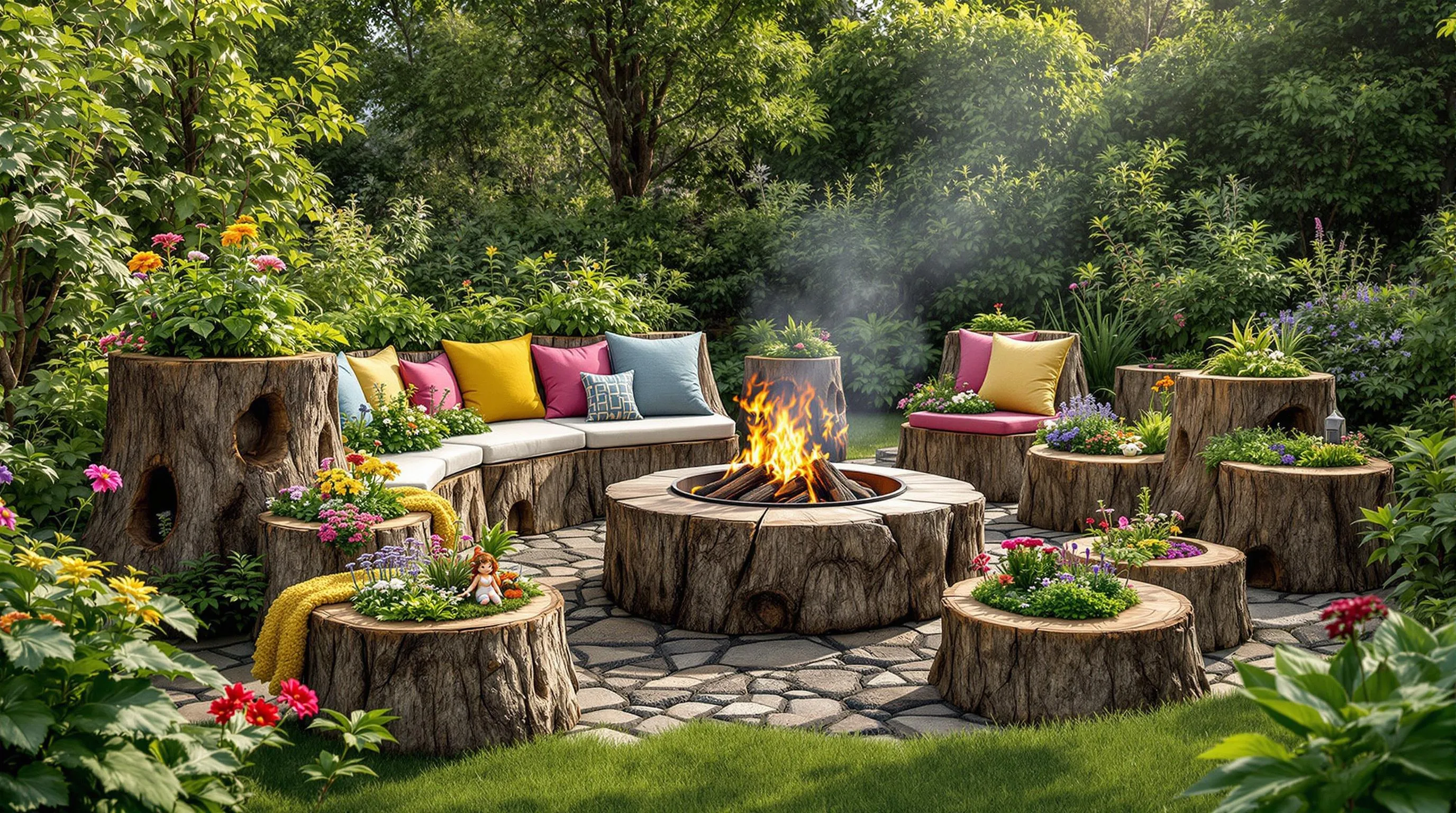
Tree stumps can transform from garden eyesores into stunning focal points with a bit of creativity. These natural elements add character and ecological value while seamlessly connecting with your existing industry.
1. Natural Woodland Seating Areas
Create charming seating areas by repurposing larger tree stumps as natural stools or chairs. Sand the top surface smooth and apply a weather-resistant sealer to ensure comfort and longevity. Arrange several stumps of varying heights around a fire pit or low table stump for an inviting woodland gathering spot. Add cushions in weather-resistant fabrics for extra comfort and a pop of color that complements your garden palette.
2. Fairy Garden Stumperies
Transform hollow stumps into magical miniature worlds that captivate visitors of all ages. Start by cleaning out the center cavity and adding drainage holes if needed. Install tiny doors, windows, and pathways using natural materials like bark, pebbles, and twigs. Incorporate miniature furniture, figurines, and accessories to create enchanting fairy scenes. Plant small-scale vegetation like moss, tiny ferns, and miniature ivy to complete the whimsical effect.
3. Multi-Tiered Planter Displays
Convert stumps into striking multi-level planters by hollowing out the centers at different depths. Drill drainage holes at the bottom of each cavity and fill with quality potting soil. Plant cascading flowers on higher stumps and shade-loving varieties in lower positions. This arrangement creates visual interest through varying heights while showcasing complementary plant collections.
4. Natural Bird Bath Stations
Create wildlife-friendly bird baths by carving shallow depressions into flat stump tops. Seal the bowl area with waterproof sealant to prevent rotting and ensure water retention. Position these natural bird baths at different heights throughout your garden to attract various bird species. Add small rocks or pebbles for perching spots where birds can safely land before bathing.
5. Living Art Sculpture Bases
Use substantial stumps as bases for living art installations. Attach mounting brackets to secure driftwood, metal sculptures, or garden art pieces to the stump surface. Plant climbing vines like clematis or ivy around the base to gradually integrate the sculpture with living elements. The contrasting textures of wood, metal, and foliage create visually compelling focal points.
6. Rustic Side Tables
Transform flat-topped stumps into functional outdoor side tables for your garden seating areas. Sand the surface smooth and apply several coats of outdoor polyurethane for protection. Add decorative elements like mosaic tile inlays or embedded river stones for personalized touches. Place these natural tables beside garden benches or Adirondack chairs to hold drinks, books, or potted plants.
7. Whimsical Mushroom Gardens
Carve and paint stumps to resemble oversized woodland mushrooms for playful garden accents. Use weather-resistant outdoor paints in bright colors for toadstool caps and white spots. Group multiple mushroom stumps of different sizes together to create a storybook-like vignette. Surround with low-growing ground covers like creeping thyme or Irish moss to enhance the woodland atmosphere.
8. Natural Stepping Stone Paths
Incorporate flat stump cross-sections as unique stepping stones throughout your garden. Cut stumps into 2-3 inch thick rounds and treat with preservative to extend their lifespan. Arrange them in meandering patterns to create inviting pathways through planting areas. Plant creeping thyme or moss between the rounds to soften edges and create a cohesive look.
9. Vertical Garden Displays
Mount smaller stumps on walls or fences to create distinctive vertical planting surfaces. Hollow out sections to accommodate soil and small plants like succulents, air plants, or trailing herbs. Arrange multiple stumps at different heights for a three-dimensional living wall effect. This approach maximizes growing space while creating a sculptural garden feature.
10. Illuminated Garden Accents
Transform hollow stumps into magical light features for evening garden enjoyment. Install solar-powered or low-voltage lighting inside hollowed stumps with decorative cutouts. Create patterns by drilling holes of varying sizes to emit dappled light patterns. Position these illuminated stumps along pathways or in dark garden corners to add atmosphere and safety lighting simultaneously.
7 Types of Plants That Thrive in Stumpery Gardens
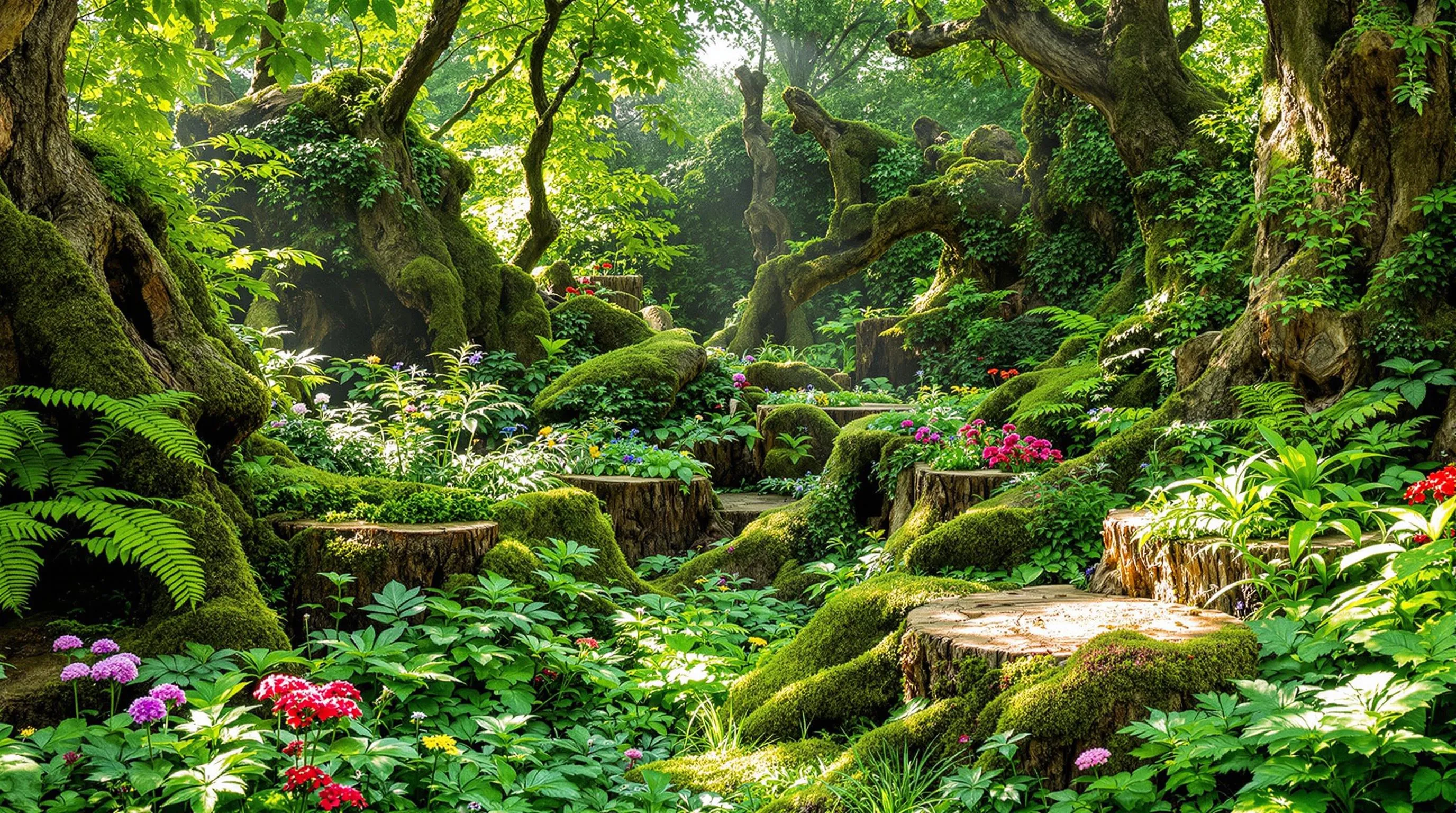
Selecting the right plants is crucial for creating a thriving stumpery garden. The decaying wood creates a unique microclimate perfect for exact plant varieties that benefit from the moisture retention and organic matter.
Ferns and Shade-Loving Perennials
Ferns are the quintessential stumpery plants, bringing authentic woodland character with their delicate fronds and prehistoric appeal. Lady ferns (Athyrium filix-femina) thrive in the dappled shade of stumps, while Japanese painted ferns (Athyrium niponicum) add stunning silver and burgundy highlights. For year-round structure, incorporate evergreen ferns like Christmas fern (Polystichum acrostichoides) or holly fern (Cyrtomium falcatum). Complement your ferns with shade-loving perennials such as hostas, whose broad leaves create dramatic contrast against rough wood textures. Tiarella (foamflower), Heuchera (coral bells), and Astilbe all perform exceptionally well in the rich, moist soil around decaying stumps, creating a layered woodland aesthetic.
Moss Varieties for a Lush Stumpery Aesthetic
Moss transforms stumps into enchanting, verdant sculptures while helping retain moisture. Sheet moss (Hypnum) creates carpet-like coverage over horizontal surfaces, while cushion moss (Leucobryum) forms rounded mounds that soften the stump’s angular edges. Irish moss (Sagina subulata) isn’t a true moss but offers similar texture with tiny white flowers in spring. For vertical stump surfaces, try rock cap moss (Dicranum) which clings effectively to bark. Establish moss by blending it with buttermilk or yogurt and painting the mixture onto damp surfaces, or press moss fragments directly into moist wood crevices during spring or fall. Regular misting helps moss establish quickly, creating that coveted ancient forest feel in your stumpery garden.
Native Woodland Wildflowers
Native woodland wildflowers bring seasonal color and ecological value to your stumpery garden. Spring ephemerals like trillium, bloodroot (Sanguinaria canadensis), and Virginia bluebells (Mertensia virginica) bloom before tree canopies leaf out, creating spectacular early-season displays. Wild ginger (Asarum canadense) offers heart-shaped leaves that form attractive ground cover throughout the growing season. Jack-in-the-pulpit (Arisaema triphyllum) adds architectural interest with its unique hooded flowers followed by bright red berry clusters. These natives have evolved to thrive in woodland conditions similar to those created by your stumpery, requiring minimal maintenance once established while supporting local pollinators and wildlife.
Woodland Bulbs
Woodland bulbs provide delightful seasonal surprises throughout your stumpery garden. Plant snowdrops (Galanthus) and winter aconite (Eranthis hyemalis) for late winter blooms that emerge through fallen leaves. Follow with daffodils that naturalize beautifully among stumps—try smaller varieties like ‘Tête-à-Tête’ or ‘Jack Snipe’ that won’t overwhelm the woodland setting. Bluebells (Hyacinthoides) create stunning carpets of color in spring, while dog-tooth violets (Erythronium) add elegant nodding flowers. For summer interest, plant hardy cyclamen that will self-seed into crevices. Position bulbs in clusters between stumps where they’ll receive adequate winter chill and spring sunshine before tree canopies leaf out.
Climbing and Trailing Plants
Climbing and trailing plants add vertical drama by softening the stumpery’s architectural elements. English ivy (Hedera helix) quickly covers vertical stumps, though consider native alternatives like Virginia creeper (Parthenocissus quinquefolia) that support local wildlife. For flowering options, try climbing hydrangea (Hydrangea anomala petiolaris) which adheres to surfaces with aerial roots, producing lacy white flowers in summer. Honeysuckle (Lonicera) attracts hummingbirds with its fragrant tubular blooms. For ground-level stumps, incorporate trailing plants like creeping Jenny (Lysimachia nummularia) or vinca minor that cascade over edges, creating a softening effect while helping to retain soil moisture.
Miniature Shrubs and Dwarf Conifers
Miniature shrubs and dwarf conifers provide year-round structure and interest in your stumpery garden. Compact rhododendrons and azaleas thrive in the acidic conditions created by decomposing wood, offering spectacular spring blooms. Look for varieties under 3 feet tall like Rhododendron ‘Ramapo’ or Azalea ‘Hino Crimson.’ Dwarf conifers like bird’s nest spruce (Picea abies ‘Nidiformis’) or Japanese false cypress (Chamaecyparis obtusa ‘Nana Gracilis’) contribute evergreen texture and winter interest. Position these architectural plants strategically as focal points among stumps, allowing their compact forms to complement rather than compete with the stumpery’s organic shapes.
Fungi and Mushrooms
Fungi and mushrooms aren’t typically planted but naturally colonize stumps, adding fascinating ecological diversity. You can encourage beneficial fungi by inoculating fresh stumps with mushroom spawn plugs—shiitake and oyster varieties are relatively easy to establish. Turkey tail fungi (Trametes versicolor) create colorful bands across wood surfaces, while chicken of the woods (Laetiporus) produces bright orange shelf-like structures. Beyond their visual appeal, these fungi speed decomposition, releasing nutrients that benefit neighboring plants. For safety, never consume wild mushrooms unless positively identified by an expert, and consider installing identification markers near interesting specimens to create educational opportunities within your stumpery garden.
How to Create a Stumpery Garden Step-by-Step
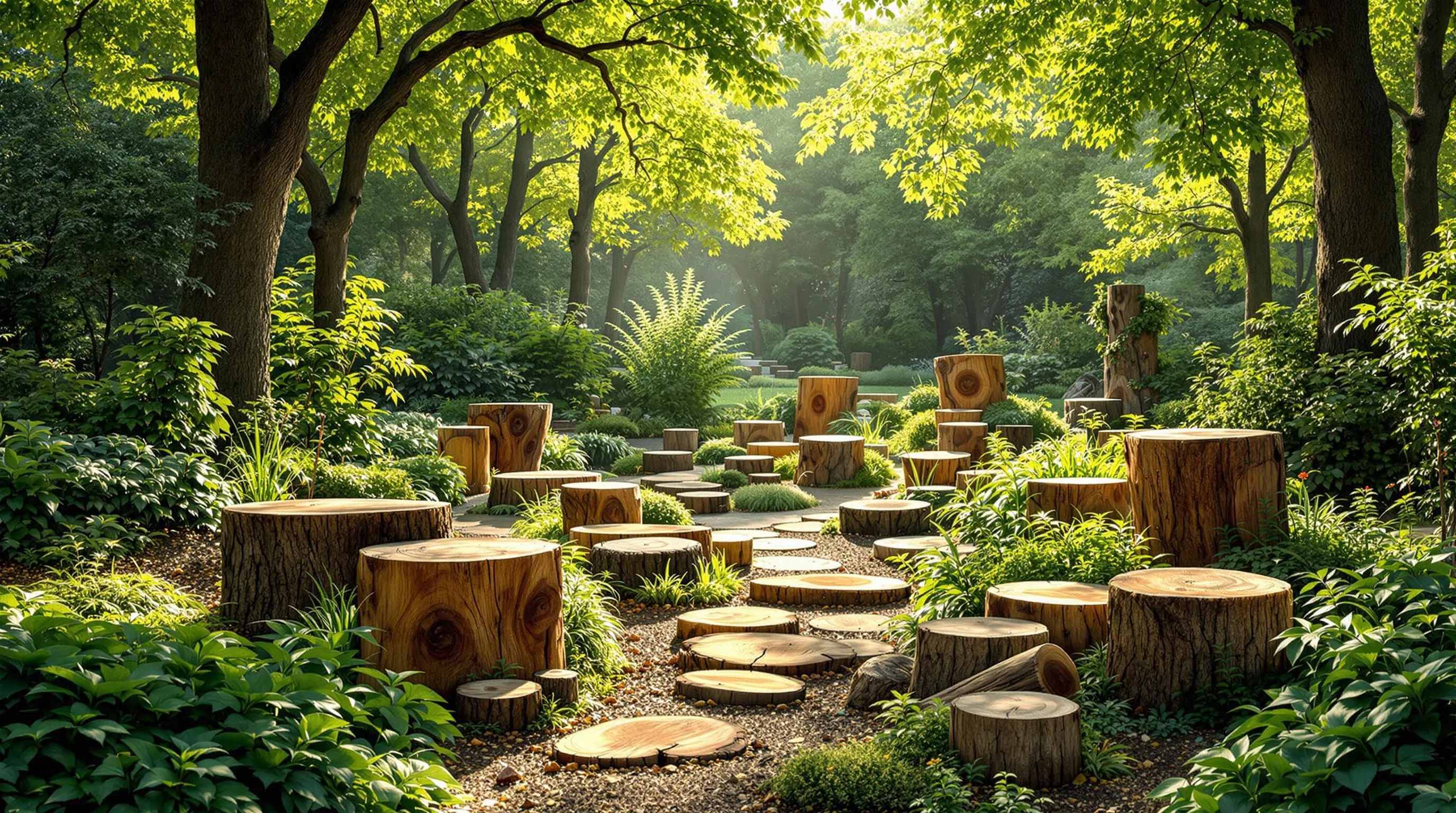
Creating your own stumpery garden is a rewarding project that combines artistry with ecological gardening. Follow these steps to transform ordinary stumps and logs into a captivating woodland feature.
Sourcing and Preparing Tree Stumps
Start your stumpery garden by sourcing appropriate wood materials. Contact local arborists, tree removal services, or forestry departments who often have stumps, logs, and root systems they’re willing to give away or sell at minimal cost. Look for hardwood varieties like oak, beech, or elm as they decompose slowly and provide longer-lasting structure. Avoid using treated wood or lumber containing chemicals that could leach into your garden soil. Before installation, clean your stumps by removing loose bark and debris, then allow them to weather naturally for several weeks. This weathering process not only enhances their appearance but also helps eliminate any pests that might be hiding within the wood. For aesthetics and stability, consider selecting stumps with interesting shapes, natural hollows, or dramatic root formations that will create visual interest in your garden display.
Positioning and Arranging Your Stumpery
Choose a partially shaded location for your stumpery garden, ideally under deciduous trees where dappled light filters through. Begin by sketching a rough layout plan to visualize how your stumps will be arranged. Position your largest stumps first, partially burying them 4-6 inches deep for stability. Create visual interest by varying heights, orientations, and textures—place some stumps upright, others horizontally, and some at angles to mimic a natural woodland scene. Leave adequate spaces between stumps to accommodate planting areas. Consider creating tiers or levels for a more ever-changing industry effect, with larger stumps forming the backdrop and smaller pieces positioned toward the front. Incorporate pathways through your stumpery to allow for maintenance access and viewing opportunities. Add smaller logs, branches, and driftwood pieces to fill gaps and create a cohesive, natural-looking arrangement. Once positioned, allow your stumpery to settle for several weeks before adding plants to ensure stability.
Budget-Friendly Stumpery Ideas for Small Gardens

You don’t need a large space or hefty budget to create a charming stumpery garden. For small urban yards or limited garden spaces, try using a single showcase stump as your focal point rather than multiple large pieces. Scout your neighborhood after storms for fallen branches or ask local tree services for scraps they’d otherwise chip. Stack smaller logs vertically against a fence or wall to create a space-saving vertical stumpery that doubles as an insect hotel. Repurpose old wooden furniture like chairs or small tables by partially burying them and allowing moss to grow over them. Create miniature stumperies in containers using small branches and wood pieces arranged with tiny ferns and woodland plants. Use hollow logs as planters to maximize your small garden footprint. Consider portable stumpery elements that can be rearranged as needed, such as smaller stumps placed in decorative pots or trays. These budget-conscious approaches let you enjoy the ecological and aesthetic benefits of a stumpery garden without requiring extensive space or resources.
Maintaining Your Stumpery Garden Through the Seasons
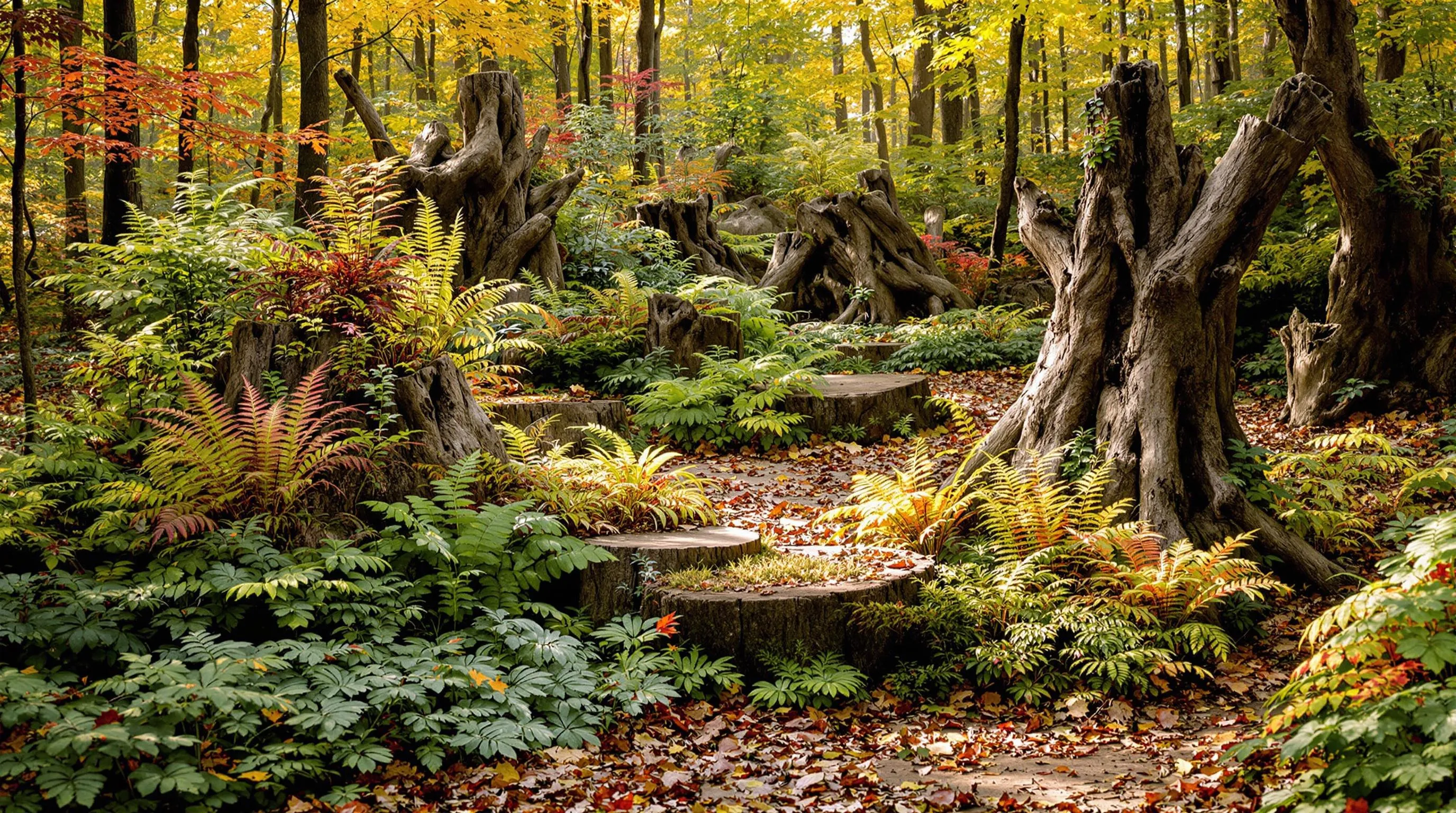
A stumpery garden requires exact seasonal care to thrive year-round. In spring, remove winter debris and add fresh compost around your plants as they emerge. Summer maintenance involves regular watering during dry spells and monitoring for pests that might damage your shade-loving specimens. As autumn approaches, collect fallen leaves to create nutrient-rich leaf mold that benefits your stumpery network. Winter offers the perfect opportunity to assess your garden’s structure and add new stumps while plants are dormant. Throughout the year, maintain proper moisture levels in your decaying wood features to support fungi growth and preserve their structural integrity. Regularly check for invasive plants that might outcompete your intended species, and gently prune overgrown areas to maintain pathways and visibility of your artistic stump arrangements. With consistent seasonal attention, your stumpery garden will continue to evolve into an increasingly rich and ever-changing woodland habitat.
Combining Stumperies with Water Features for Dramatic Effect
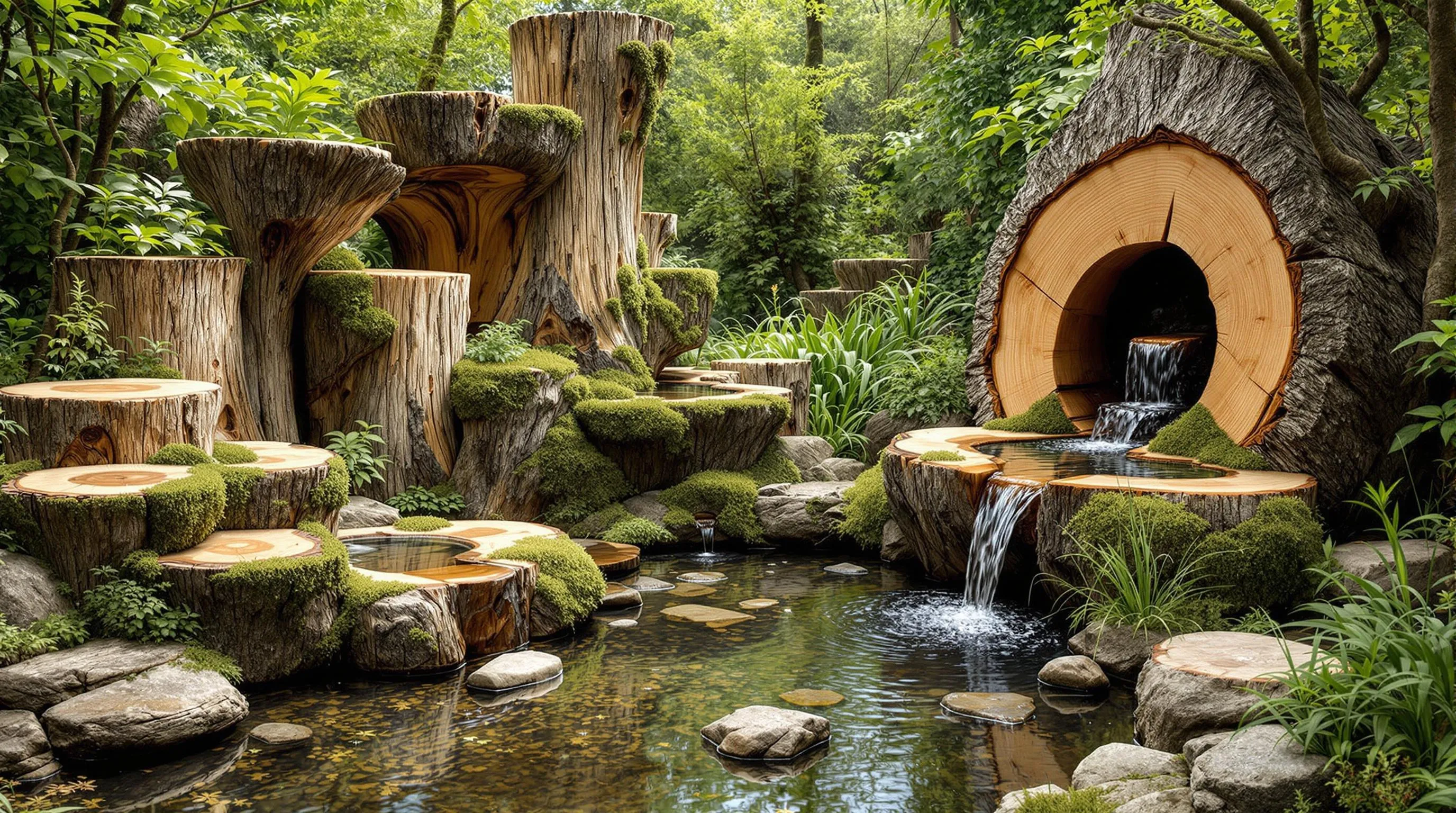
Water and wood create a stunning natural partnership in garden design. By integrating water features into your stumpery garden, you’ll create a ever-changing contrast that enhances both elements. Position a small recirculating stream to flow around and through your stump arrangement, mimicking a woodland creek. Alternatively, install a simple pond at the base of your stumpery where water can reflect the sculptural qualities of the wood. You can also create mini-waterfalls cascading over strategically placed logs, generating soothing sounds that mask urban noise. For low-maintenance options, consider embedding a small bubbling fountain within a hollowed stump or placing a shallow basin atop a flat stump surface to create a natural bird bath. The moisture from these water features also benefits your shade-loving plants while encouraging moss growth that softens the wood’s appearance. As your stumps naturally decompose, they’ll develop fascinating textures that appear even more dramatic when glistening with water droplets or partially submerged.
Famous Stumpery Gardens to Inspire Your Design

Looking for inspiration for your stumpery garden? These industry-renowned stumpery gardens showcase the incredible potential of this unique gardening style. Prince Charles’s Highgrove House features one of the most famous stumperies, created in 1996 with massive sweet chestnut stumps arranged in dramatic vertical formations. Biddulph Grange in Staffordshire stands as the original Victorian stumpery, established in the 1850s and recently restored by the National Trust. At the Vashon Island Garden Tour in Washington State, you’ll find Dan Hinkley’s acclaimed woodland garden that incorporates native stumps with rare Asian woodland plants. The Stumpery at Huntington Botanical Gardens in California offers a drought-tolerant interpretation with ferns and succulents growing among carefully positioned oak stumps. For a contemporary take, visit Heronswood Garden in Kingston, Washington, where upturned stumps create an otherworldly industry populated with rare shade-loving perennials from around the industry. These exceptional gardens demonstrate how artistic vision combined with ecological principles can transform decaying wood into enchanting industry features that improve with age.
5 Common Mistakes to Avoid When Creating a Stumpery Garden
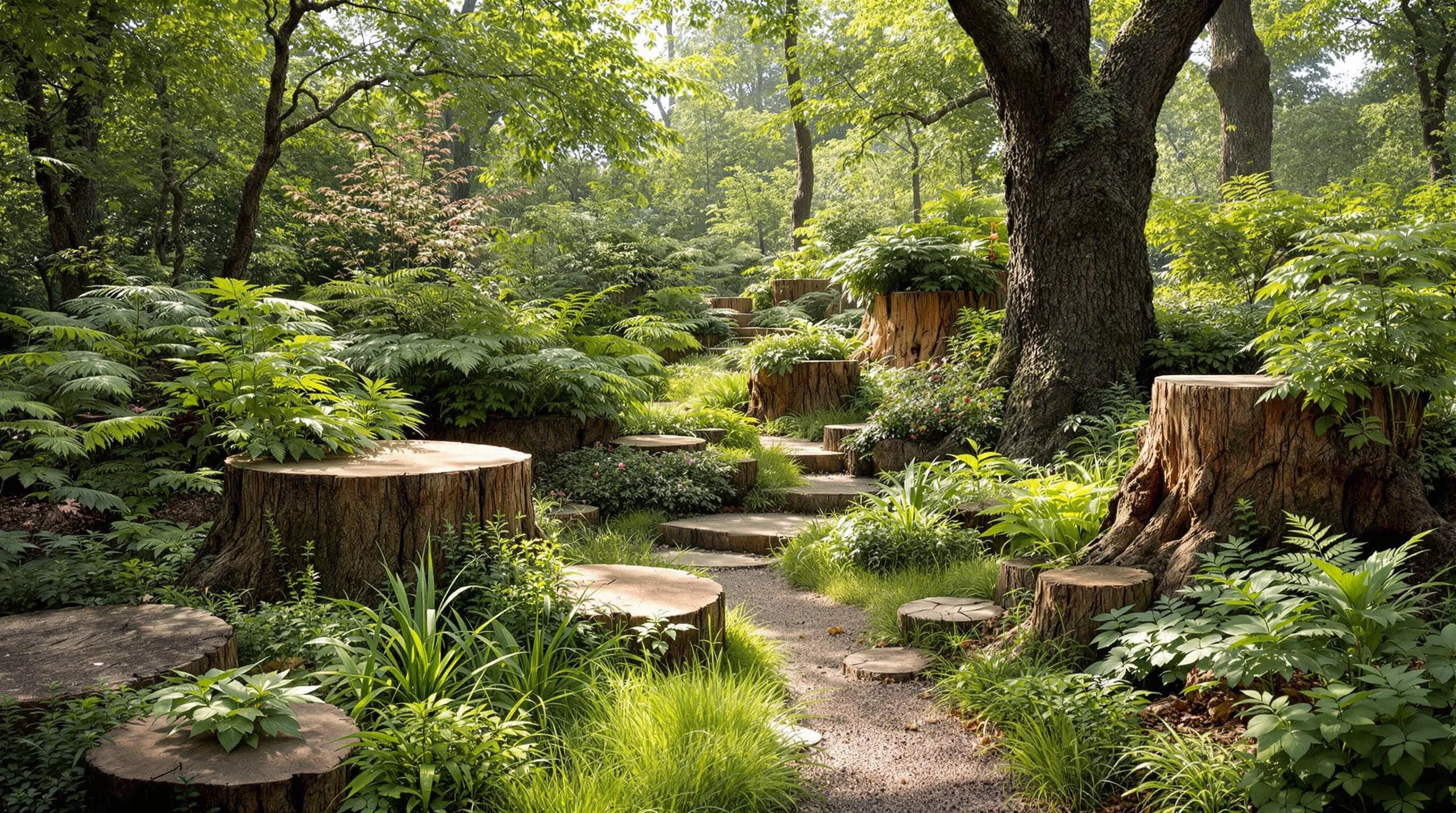
1. Using Treated or Unsuitable Wood
Using chemically treated stumps or logs is a serious mistake that can harm your garden network. Treated wood contains preservatives that can leach into the soil, damaging plants and deterring beneficial insects. Also, using softwoods like pine or cedar, which decompose too quickly, won’t provide the longevity you want in a stumpery. Instead, opt for natural hardwood stumps like oak, maple, or beech that will weather beautifully and create a sustainable habitat for years to come.
2. Improper Placement and Sunlight Exposure
Placing your stumpery in full sun is a common error that leads to rapid wood deterioration and plant stress. Most woodland plants that thrive in stumperies need dappled shade to flourish. Without proper shade, your stumps will dry out too quickly, and shade-loving plants like ferns and hostas will struggle to survive. Choose a location with partial shade, ideally under existing trees or on the north or east side of your property where direct afternoon sun won’t reach your stumpery.
3. Neglecting Proper Drainage
Failing to consider drainage can doom your stumpery garden. While decaying wood needs moisture to support fungi and moss growth, waterlogged conditions can cause excessive rot and create an unhealthy environment for many plants. Ensure your stumpery has adequate drainage by positioning it on a slight slope or incorporating drainage materials like gravel at the base of your installation. This balance of moisture retention and drainage is crucial for long-term success.
4. Overcrowding Plants and Stumps
Enthusiastic gardeners often make the mistake of cramming too many stumps and plants into their stumpery, leaving insufficient space for growth and maintenance. Overcrowding prevents proper air circulation, increases disease risk, and creates competition for nutrients. Allow adequate spacing between stumps (at least 2-3 feet) and consider the mature size of plants when positioning them. Remember that the beauty of a stumpery comes from seeing the architectural elements of the wood alongside the plants.
5. Ignoring Long-Term Maintenance Needs
Many gardeners underestimate the maintenance requirements of a stumpery garden. While these gardens are relatively low-maintenance, neglecting them entirely leads to problems like invasive plant takeovers, path obstructions, and structural issues as stumps decompose. Plan for ongoing care by establishing accessible pathways for maintenance, monitoring decomposition rates, and having a strategy for replacing stumps that have completely broken down. This foresight ensures your stumpery remains an enchanting feature rather than becoming an overgrown, inaccessible area of your garden.
Conclusion: Embracing the Natural Beauty of Stumpery Gardens
Creating a stumpery garden offers you a chance to transform what might be considered garden waste into a striking ecological feature. With options ranging from elaborate Victorian-inspired designs to simple container arrangements you’ll find a style that fits your space and budget.
Remember that your stumpery will evolve over time as the wood decays and plants mature. This natural progression is part of the beauty and appeal of these unique garden features. By combining artistic arrangement with ecological principles you’re not just creating an eye-catching garden element but also supporting local wildlife and biodiversity.
Whether you’re inspired by Prince Charles’s grand design or simply looking to repurpose a single stump your stumpery garden will become a fascinating focal point that connects you with nature’s cycles of growth decay and renewal.

